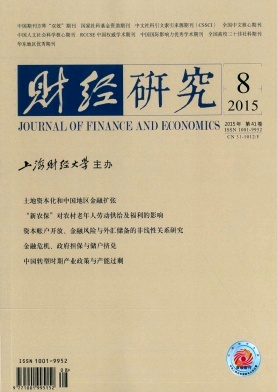人民币作为国际计价货币的模式借鉴:美元模式与欧元模式的比较分析
财经研究 2015 年 第 41 卷第 08 期, 页码:
摘要
参考文献
摘要
文章对美元与欧元充当国际贸易计价货币的相关数据进行了比较分析,指出同一因素如贸易规模占比等对不同国家选择计价货币行为的影响是不同的。值得注意的是,美元作为国际计价货币的模式在于与大宗商品进行绑定,影响其他货币被用作国际计价货币,欧盟成员国对计价货币的选择也受到这种绑定的影响。而欧盟以欧元作为国际计价货币,其影响仅体现在联盟内,并不影响非欧盟国家对国际计价货币的选择。文章认为真正的国际货币是第三国之间使用的货币,依赖进出口贸易权重的货币使用只是货币国际化的初级阶段。文章对人民币国际化的启示在于,短期内可以通过贸易项与双边货币互换来推动人民币作为国际计价货币(欧元模式),但在长期应掌握大宗商品的计价权(美元模式)。
[1]李超.中国的贸易基础支持人民币区域化吗?[J].金融研究,2010,(7):1-17.
[2]陆前进.贸易结算货币的新选择:稳定的篮子货币——对“金砖五国”货币合作的探讨[J].财经研究,2012,(1):94-102.
[3]沈国兵.日元与人民币:区域内货币合作抑或货币竞争[J].财经研究,2004,(8):28-39.
[4]石建勋,钟建飞,李海英.外部供需冲击视角下的东亚货币合作可行性研究[J].财经研究,2012,(3):37-48.
[5]孙杰.跨境结算人民币化还是人民币国际化?[J].国际金融研究,2014,(4):39-49.
[6]余永定.再论人民币国际化[J].国际经济评论,2011,(5):7-13.
[7]余永定.从当前的人民币汇率波动看人民币国际化[J].国际经济评论,2012,(1):18-26.
[8]张远军.中俄间人民币跨境流通的理论与实证研究[J].金融研究,2011,(6):194-206.
[9]Bacchetta P, Van Wincoop E. A theory of the currency denomination of international trade[J]. Journal of International Economics, 2005, 67(2): 295-319.
[10]Chinn M, Frankel J A. Will the euro eventually surpass the dollar as leading international reserve currency?[A].Clarida R.G7 Current account imbalances: Sustainability and adjustment[C].Chicago:University of Chicago Press, 2007.
[11]Donnenfeld S, Haug A. Currency invoicing in international trade:An empirical investigation[J]. Review of International Economics, 2003, 11(2): 332-345.
[12]Goldberg L S, Tille C. A bargaining theory of trade invoicing and pricing[R]. NBER Working Paper No.18985, 2013.
[13]Goldberg L S, Tille C. The dynamics of international trade invoicing[R]. Working Paper, 2009.
[14]Goldberg L S, Tille C. Vehicle currency use in international trade[J]. Journal of International Economics, 2008, 76(2): 177-192.
[15]Grassman S. Currency distribution and forward cover in foreign trade: Sweden revisited, 1973[J]. Journal of International Economics, 1976, 6(2): 215-221.
[16]Ito H, Chinn M. The rise of the “Redback” and China’s capital account liberalization:An empirical analysis on the determinants of invoicing currencies[R].Paper prepared for the ADBI Conference,2013.
[17]Ito T, Koibuchi S, Sato K, et al. Why has the yen failed to become a dominant invoicing currency in Asia? A firmlevel analysis of Japanese Exporters’ invoicing behavior[R]. NBER Working Paper No.16231,2010.
[18]Kamps A. The Euro as invoicing currency in international trade[R]. European Central Bank Working Paper Series, 2006.
[19]Krugman P. Scale economies, product differentiation, and the pattern of trade[J]. American Economic Review,1980,70(5): 950-959.
[20]Lai E L C, Yu X. Invoicing currency in international trade: An empirical investigation and some implications for the Renminbi[J].World Economy,2014,38(1):193-229.
[21]Ligthart J, Da Silva J. Currency invoicing in international trade:A panel data approach[J]. SSRN Working Paper, 2007.
[22]Matsuyama K, Kiyotaki N, Matsui A. Toward a theory of international currency[J]. Review of Economic Studies, 1993, 60(2): 283-307.
[23]McKinnon R I. Money in international exchange: The convertible currency system[M].Oxford:Oxford University Press, 1979.
[24]Oi H, Otani A, Shirota T. The choice of invoice currency in international trade:Implications for the internationalization of the yen[R]. Institute for Monetary and Economic Studies, Bank of Japan, 2003.
[25]Page S A B. Currency of invoicing in merchandise trade[J]. National Institute Economic Review, 1977, 81(1): 77-81.
[26]Rey H. International trade and currency exchange[J]. Review of Economic Studies, 2001, 68(2): 443-464.
[27]Samiee S, Patrik A. Currency choice in industrial pricing:A crossnational evaluation[J]. Journal of Marketing, 1998,62(3):112-127.
[28]Tavlas G S. The international use of the US dollar:An optimum currency area perspective[J]. World Economy, 1997, 20(6): 709-747.
The Mode of RMB as International Pricing Currency:
[2]陆前进.贸易结算货币的新选择:稳定的篮子货币——对“金砖五国”货币合作的探讨[J].财经研究,2012,(1):94-102.
[3]沈国兵.日元与人民币:区域内货币合作抑或货币竞争[J].财经研究,2004,(8):28-39.
[4]石建勋,钟建飞,李海英.外部供需冲击视角下的东亚货币合作可行性研究[J].财经研究,2012,(3):37-48.
[5]孙杰.跨境结算人民币化还是人民币国际化?[J].国际金融研究,2014,(4):39-49.
[6]余永定.再论人民币国际化[J].国际经济评论,2011,(5):7-13.
[7]余永定.从当前的人民币汇率波动看人民币国际化[J].国际经济评论,2012,(1):18-26.
[8]张远军.中俄间人民币跨境流通的理论与实证研究[J].金融研究,2011,(6):194-206.
[9]Bacchetta P, Van Wincoop E. A theory of the currency denomination of international trade[J]. Journal of International Economics, 2005, 67(2): 295-319.
[10]Chinn M, Frankel J A. Will the euro eventually surpass the dollar as leading international reserve currency?[A].Clarida R.G7 Current account imbalances: Sustainability and adjustment[C].Chicago:University of Chicago Press, 2007.
[11]Donnenfeld S, Haug A. Currency invoicing in international trade:An empirical investigation[J]. Review of International Economics, 2003, 11(2): 332-345.
[12]Goldberg L S, Tille C. A bargaining theory of trade invoicing and pricing[R]. NBER Working Paper No.18985, 2013.
[13]Goldberg L S, Tille C. The dynamics of international trade invoicing[R]. Working Paper, 2009.
[14]Goldberg L S, Tille C. Vehicle currency use in international trade[J]. Journal of International Economics, 2008, 76(2): 177-192.
[15]Grassman S. Currency distribution and forward cover in foreign trade: Sweden revisited, 1973[J]. Journal of International Economics, 1976, 6(2): 215-221.
[16]Ito H, Chinn M. The rise of the “Redback” and China’s capital account liberalization:An empirical analysis on the determinants of invoicing currencies[R].Paper prepared for the ADBI Conference,2013.
[17]Ito T, Koibuchi S, Sato K, et al. Why has the yen failed to become a dominant invoicing currency in Asia? A firmlevel analysis of Japanese Exporters’ invoicing behavior[R]. NBER Working Paper No.16231,2010.
[18]Kamps A. The Euro as invoicing currency in international trade[R]. European Central Bank Working Paper Series, 2006.
[19]Krugman P. Scale economies, product differentiation, and the pattern of trade[J]. American Economic Review,1980,70(5): 950-959.
[20]Lai E L C, Yu X. Invoicing currency in international trade: An empirical investigation and some implications for the Renminbi[J].World Economy,2014,38(1):193-229.
[21]Ligthart J, Da Silva J. Currency invoicing in international trade:A panel data approach[J]. SSRN Working Paper, 2007.
[22]Matsuyama K, Kiyotaki N, Matsui A. Toward a theory of international currency[J]. Review of Economic Studies, 1993, 60(2): 283-307.
[23]McKinnon R I. Money in international exchange: The convertible currency system[M].Oxford:Oxford University Press, 1979.
[24]Oi H, Otani A, Shirota T. The choice of invoice currency in international trade:Implications for the internationalization of the yen[R]. Institute for Monetary and Economic Studies, Bank of Japan, 2003.
[25]Page S A B. Currency of invoicing in merchandise trade[J]. National Institute Economic Review, 1977, 81(1): 77-81.
[26]Rey H. International trade and currency exchange[J]. Review of Economic Studies, 2001, 68(2): 443-464.
[27]Samiee S, Patrik A. Currency choice in industrial pricing:A crossnational evaluation[J]. Journal of Marketing, 1998,62(3):112-127.
[28]Tavlas G S. The international use of the US dollar:An optimum currency area perspective[J]. World Economy, 1997, 20(6): 709-747.
The Mode of RMB as International Pricing Currency:
引用本文
楚国乐, 吴文生. 人民币作为国际计价货币的模式借鉴:美元模式与欧元模式的比较分析[J]. 财经研究, 2015, 41(8): 0.
导出参考文献,格式为:





 10032
10032  3927
3927

